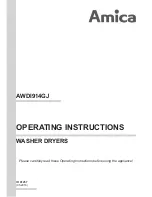
7
Troubleshooting Chart - Electric Pressure Washers Only
Pressure washer does not
start up
Pump does not reach neces-
sary pressure
Fluctuating pressure
Excessive water leaking from
pump
Motor stops suddenly
1.
Plug is not well connected or electric socket is faulty
2.
The main voltage supply is too low
3.
Thermal safety switch has tripped
4.
GFCI has tripped (If so equipped)
1.
Water inlet filter is clogged
2.
Pump sucking air from connection or hoses
3.
Suction delivery valves are clogged or worn out
4.
Lance nozzle not correct or worn out
5.
Unloader clogged or worn
1.
Pump sucking in air
2.
Valves dirty, worn out or stuck
3.
Water seals worn out
4.
Tip (nozzle) clogged
Water seals worn out
Thermal safety switch has tripped due to overheating
1.
Check plug, socket and fuses
2.
Check that the main supply voltage is adequate
3.
Switch off the unit and allow the motor to cool
down. Leave the lance open.
4.
Push reset button
1.
Clean water inlet filter
2.
Check that connections and locking ring are properly
tightened
3.
Call 1-800-330-0712
4.
Call 1-800-330-0712
5.
Call 1-800-330-0712
1.
Check that hoses and connections are tight
2.
Call 1-800-330-0712
3.
Call 1-800-330-0712
4.
Clean tip (nozzle) w/tip cleaner
Call 1-800-330-0712
1.
Check that the main supply voltage corresponds to
the specifications
2.
Switch the unit off and let it cool down
Symptom
Possible Cause(s)
Corrective Action(s)
Operation (Continued)
NEVER disconnect
the high pressure
discharge hose from the machine while
the system is pressurized. To depressurize,
turn engine/motor off, turn water supply
off and squeeze gun trigger 2-3 times.
5. After each use, wipe all surfaces of
the pressure washer with a clean,
damp cloth.
•
Do not store the pressure washer out-
doors.
!
WARNING
•
Do not store the pressure washer
where it might freeze unless it has
been properly winterized. A winteriz-
ing kit is available for cold weather
storage.
TIPS FOR EXTENDING THE LIFE OF
YOUR PRESSURE WASHER
1. Never operate the unit without water.
2. Your pressure washer is not meant to
pump hot water. Never connect your
pressure washer to a hot water supply
as it will significantly reduce the life of
the pump.
3. Running the unit for more than 2
minutes without spraying water caus-
es heat to build up in the pump. This
is hard on many of the pump compo-
nents and this practice should be
avoided.
4. Release the trigger prior to switching
lance between high and low pressure.
Failure to do so may reduce the life of
the o-rings in the lance.
6. Storage
www.campbellhausfeld.com
Troubleshooting Chart - Gasoline Powered Pressure Washers Only
Symptom
Possible Cause(s)
Corrective Action(s)
Engine will not start or is hard
to start
Engine misses or lacks power
Low pressure and/or pump
runs rough
1.
No gasoline in fuel tank or carburetor
2.
Low oil
3.
Start/Stop switch in stop position
4.
Water in gasoline or old fuel
5.
Dirty air cleaner filter
6.
Spark plug dirty, wrong gap or wrong type
7.
Spray gun closed
8.
Other causes
1.
Partially plugged air cleaner filter
2.
Spark plug dirty, wrong gap or wrong type
1.
Worn or wrong size tip
2.
Inlet filter clogged
3.
Worn packings, abrasives in water or natural wear
4.
Fouled or dirty inlet or discharge valves
5.
Restricted inlet
6.
Worn inlet or discharge valves
7.
Leaking high pressure hose
8.
Pump drawing in air
9.
Unloader valve seat faulty or worn
1.
Fill the tank with gasoline,open fuel shut off valve.
Check fuel line and carburetor
2.
Check oil level. Fill if necessary
3.
Move switch to start position
4.
Drain fuel tank and carburetor. Use new fuel and dry
spark plug
5.
Remove and clean
6.
Clean, adjust the gap or replace
7.
Trigger spray gun
8.
See engine owner’s manual
1.
Remove and clean
2.
Clean, adjust the gap or replace
1.
Replace with tip of proper size
2.
Clean. Check more frequently
3.
Check filter. Replace packings. See service center
4.
Clean inlet and discharge valve assemblies. Check filter
5.
Check garden hose, may be collapsed or kinked. Check
inlet water flow
6.
Replace worn valves
7.
Replace high pressure hose
8.
Ensure hoses and fittings are tight
9.
Check and replace


























